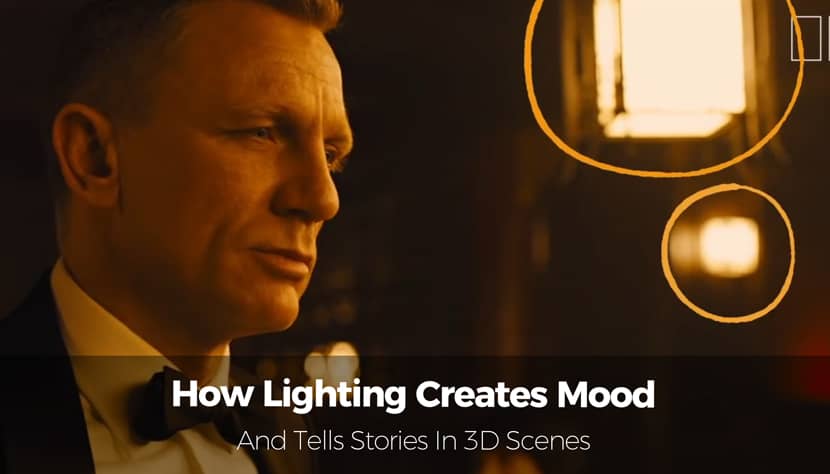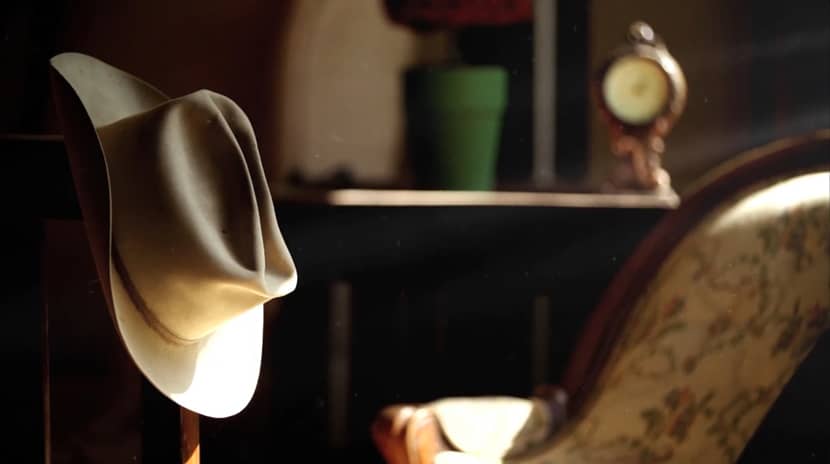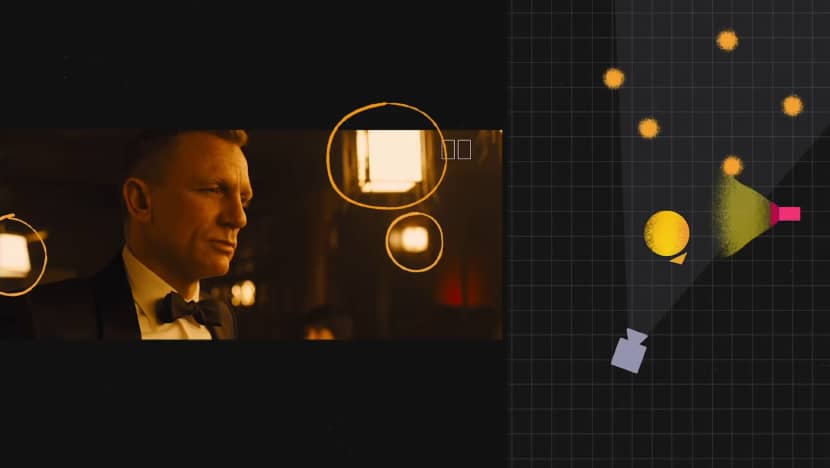
Despite being one of the most effective storytelling elements in 3D art, lighting is frequently the least understood. Whether you're creating a dramatic cinematic shot, an atmospheric interior, or a simple mood-driven render, the way you manipulate light affects your audience's emotions before they even know why. In addition to learning useful strategies you can use to improve your storytelling and creative impact, this article will show you how lighting can transform technically correct images into emotionally storytelling scenarios.
Renders that are technically correct often look perfect on the surface but have a strangely empty feeling. The image lacks emotion despite having a clean model, attractive textures, and well-polished details. Many 3D artists deal with this silent problem, particularly as rendering technologies get more potent. The power of an image to evoke a feeling in the viewer is what really elevates it when accuracy alone is no longer impressive. That emotional connection rarely comes from geometry or shaders but it comes from light.
Realism and storytelling can be reconciled by adopting a director's perspective rather than a technician's. A filmmaker use light to influence emotion, convey psychology, and build a story in addition to revealing form. Usually, the lighting has already sown the idea of warmth, danger, nostalgia, loneliness, or optimism in the viewer. Lighting in 3D art transforms into a silent language that expresses mood significantly more successfully than any individual model or texture.
The universality of lighting is what gives it even greater strength. The emotional concepts remain the same whether you work in Octane, Arnold, Corona, V-Ray, or Cycles. Although different render engines may provide different tools, the fundamental idea that lighting tells a story is always the same. Understanding this language is what transforms a good 3D artist into a compelling visual narrator.
The Psychology of Light - Why Mood Starts with Perception.
Humans have an innate reaction to light. Warm light has always been a sign of human presence, fire, safety, community, and sunset. Cool light seems silent, far away, and even tense. Long before the scientific aspect of lighting is discussed, these emotional connections are present. They have biological roots and cultural reinforcement.
Darkness suggests danger, secrecy, and mystery, whereas light frequently represents clarity, truth, revelation, and goodness in Western traditions. Shadow has deeper connotations in many Eastern visual traditions, implying nuance, reflection, or the beauty of the invisible. Lighting becomes more than just illumination when an artist grasps these interpretive complexities; it becomes a psychological cue.
Light also shapes perception by guiding the eye and the brightest part of a composition naturally attracts our attention. Value hierarchy is controlled by artists, who determine what the audience sees initially, what they learn next, and what is kept hidden. A well-lit scene is essentially visual storytelling through controlled attention. The artist controls temperature, location, falloff, and contrast to influence not just what the audience sees but also how they feel about it.
Lighting Techniques: Color, Contrast, and Shadows.
Before diving into specific lighting methods, it's helpful to realize that they all have the same goal: to affect the viewer's emotional experience. In addition to being purely decorative elements, color, contrast, and shadows are also narrative tools that quietly affect mood, intensity, and meaning. The ways in which each component enhances the cinematic narrative within 3D scenes are explored in the sections that follow.
Color Temperature and Emotion.
Color temperature has an immediate and powerful impact on mood. A feeling of coziness, romanticism, nostalgia, or assurance is evoked by warm tones. An intimate atmosphere is immediately created by a candlelight room, a low lighting, or a warm sunset. Cool temperatures, on the other hand, conjure feelings of sterility, suspense, emotional remoteness, or loneliness. A futuristic lab, a moonlit alley, or a foggy dawn all seem colder—not just practically, but also emotionally.
Cinematic lighting often mixes temperatures for emotional effect. The emotional focal point is immediately a character lit by warm inside light against a cool blue night sky. The chilly, steely color scheme employed in thrillers and the golden-hour warmth used in romance plays are two classic examples. A villa illuminated with chilly early morning tones conveys clarity, stillness, and solitude, while a hotel bathed in warm sunset light feels luxurious and welcoming, even in ArchViz.

"Luxury Hotel" By Batis Studio
The StudioBinder video below, provides a clear breakdown of color temperature in cinematography and explains why it is so important in establishing mood and ambiance. It describes how various light sources produce varying Kelvin temperatures, how white balance impacts how these temperatures show up on camera, and how filmmakers work with it to create particular effects using gels, filters, and camera settings. The video demonstrates how intentional changes in warm and cool tones can define character, indicate time changes, heighten tension, or support a story's emotional arc through real-world examples from movies including A Ghost Story, Palm Springs, and Ozark. In the end, it emphasizes that employing light as a potent storytelling tool is the key to understanding color temperature.
Contrast and Depth.
Contrast is one of the best methods for managing tension and drama in a scene. Emotional intensity is heightened by high contrast. Bright highlights combined with deep shadows produce a striking, dramatic, or thrilling cinematic appearance. Conversely, low contrast softens the tone and fosters a serene or mild atmosphere.
Sharp, defined shadows created by hard light amplify tension and highlight details. Shadows are dispersed by soft light, which facilitates seamless transitions and conveys a sense of calm or ease. Artists frequently use tougher sources and sharper contrast in scenes from sci-fi, horror, and thrillers. Light is typically softer, wider, and more forgiving when it comes to romantic or lifestyle visualizations.
Contrast is also the source of depth. The artist adds visual layers that give the image a more dynamic and cinematic feel by purposefully differentiating the light levels in the foreground, midground, and background. Even the most detailed 3D models can appear flat without this distinction.
In this video, Horoma School's Simon Oudiette demonstrates the Greatest Area of Contrast (GAC), one of the fundamental concepts of visual perception. He explains how, regardless of whether the area contains the brightest or darkest point in the picture, our eyes are naturally pulled to the place where the lightest light meets the darkest dark. He demonstrates how the GAC directs viewer attention, defines visual storytelling, and even supersedes conventional composition conventions like the rule of thirds in landscapes, portraits, and cityscapes. Artists need to know how contrast works, how the eye groups or tracks different areas of contrast, and why things like the sky or intense specular highlights are sometimes ignored without realizing it. If you want the viewer to look at your intended subject first, you need to intentionally control the location and strength of the GAC — because contrast, not composition grids, determines where the story begins.
Shadows as Storytelling Tools.
Shadows have their own psychology and the unknown is suggested by darkness. Depending on the situation, a partially hidden issue may seem threatening, enigmatic, or personal. Shadows are frequently employed in cinematic lighting to conceal as much as to expose, leaving the viewer's imagination to fill in the blanks.

"Shaping Shadows for Cinematic Storytelling" By CNOMADIC.
Technically, diffusion, distance from the subject, and light source size all affect how soft the shadow is. Narrative intention is established by direction: downhill shadows feel expected, side-cast shadows feel dramatic, and upward shadows feel strange or unnerving. Mastering shadow behavior gives artists subtle control over their emotions.
Shadows also help to guide composition, add realism, and anchor objects to their surroundings in 3D environments. Intentional shadows give a scene emotion, while their absence renders it sterile.
In this CNOMADIC video, we learn that true brightness has less to do with adding more light and far more to do with shaping shadows. By creating a greater contrast between the highlights and the surrounding darkness, the crteator shows how lowering the total illumination may make a subject appear brighter. He illustrates how focusing on important elements, such as a character getting out of a car, a student's face, or a farmer's hat, may precisely direct the viewer's eye through real-world examples that draw inspiration from classic Hitchcock lighting techniques. The lesson is straightforward yet impactful: eliminate lighting, shape it, and allow contrast tell the tale to make something stand out instead of simply adding it.
How to Apply Cinematic Lighting in Different Genres?
3D scenes benefit from similar stylistic decisions, just as different film genres depend on particular lighting aesthetics. Due to decades of filmmaking, each genre has its own visual vocabulary. By understanding these conventions, artists can produce instantly recognizable moods that resonate with viewers. The following sections examine how different narrative categories affect lighting strategies.
Genre Lighting Styles.
- Thriller and horror scenes usually depend on cool tones, directed shadows and unstable movement. Anxiety is increased by narrow beams, flickering sources, and slashes of moonlight. The psychological discomfort is exacerbated by the lack of warmth.
- Romance and drama thrive on softness. An aura of tenderness and emotional fragility is produced by mild temperatures, soft shadows, golden-hour illumination, and a variety of sources. These images frequently have an ethereal quality when paired with subtle bloom.
- Sci-fi and cyberpunk prioritize artificial color. Futuristic worlds are created with neon highlights, vibrant cyans and magentas, dramatic contrasts, and volumetric haze. Reflective surfaces and hard highlights heighten the sense of technological sophistication.
- Fantasy and adventure scenes often rely on magical or non-traditional sources. Rim lights emphasize heroic silhouettes, while glowing objects, enchanted lanterns or otherworldly beams establish a sense of wonder.
I have discovered a great resource that covers the basics of creating different lighting styles with just two lights after much time spent looking on YouTube. Although it might seem unexpected at first, as 3D artists, we're constantly looking for clever, effective methods that enable us to produce high-quality outputs more quickly. This tutorial "The Art of Lighting | 4 Film Genres with Just 2 Lights" by Blake Ridder does just that.
Time and Atmosphere.
Time of day is one of the most effective storytelling tools. Dawn is calm and full of hope. Dusk has a romantic or nostalgic atmosphere. The night seems enigmatic or alienating. Midday seems neutral, honest, and transparent.
The emotional tone is enhanced by atmospheric components such as volumetrics, fog, and light rays. Scenes are softer, less clear, and more mysterious when there is fog. Magnificence and wonder are produced by volumetric shafts. Light direction can be emphasized and dramatic depth increased with even a small amount of haze.
Changing the time of day can drastically alter the story in architectural visualization. A space may feel serene at sunrise, alive at noon, intimate at sunset, and contemplative at night.
Practical Lights as Story Elements.
Practical lights are visible sources within a scene, and they add narrative layers beyond illumination.

"Roger Deakins and the Art of Practical Lighting" By StudioBinder.
- Windows can represent connection, clarity, opportunity, or escape. A brilliant window behind a character or interior scene immediately conveys a sense of hope, transition, or the outside world.
- Candles and fire have a primitive, personal, or hazardous sense. They immediately enrich the ambiance by adding warmth and organic movement.
- Screens and monitors radiate cold, solitary light that communicates isolation, technology, or information overload. They are prevalent in contemporary drama and science fiction.
- Neon signs convey information about nightlife, commerce or urban chaos. They produce the color and stylistic individuality that characterize entire environments.
All these sources help ground the lighting in believable story moments while adding emotional cues.
3D Lighting Tutorial: Building a Lighting Narrative Step by Step.
Since all of the videos included in this article already go over the main ideas of how lighting sets the tone and tells tales, we won't go into too much detail here. Instead, we'll go on to a brief, step-by-step guide that describes how to actually build a lighting narrative in a way that reflects the emotional journey of a character or environment. Instead of approaching lighting as a purely technical task, you treat it as a narrative process with evolving intention.
The Three-Act Lighting Structure.
Act 1: Lighting can echo the dramatic arc of storytelling. The lighting should feel balanced and comfortable. Nothing is threatening, nothing pulls the viewer in a specific emotional direction. This establishes the baseline mood.
Act 2: As the story moves, the lighting shifts toward contrast. The color temperature may cool down or warm up depending on the emotional conflict. Shadows deepen, and the environment becomes more expressive. This visual tension supports narrative evolution.
Act 3: The lighting resolves. Either it returns to the original calm, or it stabilizes at a new emotional equilibrium. This might mean softened contrast, returning warmth, or a stable color blend that reflects character transformation.
Imagine a character standing in an old apartment. At the beginning, sunlight enters gently. As tension builds, only a sliver of cold blue light remains. By the end, a warm lamp illuminates the room, representing emotional closure. Light mirrors emotion.
Workflow Steps:
- Define the emotional journey of the scene or character.
- Choose a color palette and temperature range.
- Set key light and contrast.
- Place practical lights with narrative purpose.
- Add atmospheric elements.
- Test the emotional reading of the scene.
- Quickly iterate variations — use RebusFarm for fast rendering.
As an example In this H8urs exclusive, cinematographer Eric Lin breaks down how he utilized lighting to track the emotional arc of the characters in Hearts Beat Loud.
What Are the Most Common Emotional Lighting Mistakes?
In an attempt to make everything apparent, many artists over-light their scenes. However, excessive light destroys drama and storyline possibilities. Nothing seems significant when everything is brilliant. Emotion is eliminated when shadow is eliminated since it is just as significant as light.
Color temperature mixing without narrative aim is another common error. The spectator perceives an imbalance if warm and cool lights appear together without any apparent explanation. Instead of confusing the plot, each temperature change should enhance it.
Motivated lighting is also often ignored. If a bright rim light appears in a place with no plausible source, the illusion breaks. Cinema always justifies light, even when stylized. Viewers forgive exaggeration but not inconsistency.
Finally, many artists attempt to make every render look epic. When everything is epic, nothing is. Emotional storytelling requires range: calmness, tension, mystery, relief. Without variation, the visual journey feels monotonous.
Conclusion.
In visual art, light is the purest expression of emotion. It has the power to unveil, upend, comfort, conceal, or change. It transforms a 3D scene from a technical demonstration to an emotive experience when used purposefully. Renders become memories as a result. It transforms settings into narratives.
Thoughtful lighting is what transforms a technician into an artist. Every render transforms from a static image into a narrative moment once you start thinking like a director, directing attention, establishing mood, and coordinating color and contrast.
And as experimentation is essential to lighting, RebusFarm becomes a powerful ally. Without having to wait hours on local computers, artists may immediately test mood variations, refine atmosphere and intensity, and experiment with emotional alternatives thanks to rapid cloud rendering. This speed unlocks creative freedom, letting lighting evolve the same way stories do: through exploration, refinement and emotional intention.
When you treat light as narrative rather than utility, your 3D scenes stop being pictures. They become experiences. They speak. They breathe. They live.
I appreciate you reading! I hope this article helped you see lighting as a creative element that influences narrative and emotion rather than only a mechanical phase. we’re all connected by the same passion for 3D art and the desire to keep pushing it forward.
Kind regards & Keep rendering! 🧡

About the author
Vasilis Koutlis, the founder of VWArtclub, was born in Athens in 1979. After studying furniture design and decoration, he started dedicating himself to 3D art in 2002. In 2012, the idea of VWArtclub was born: an active 3D community that has grown over the last 12 years into one of the largest online 3D communities worldwide, with over 160 thousand members. He acquired partners worldwide, and various collaborators trusted him with their ideas as he rewarded them with his consistent state-of-the-art services. Not a moment goes by without him thinking of a beautiful image; thus, he is never concerned with time but only with the design's quality.

